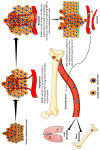Molecular Crosstalk Between RUNX2 and HIF-1α in Osteosarcoma: Implications for Angiogenesis, Metastasis, and Therapy Resistance
- PMID: 40806771
- PMCID: PMC12347496
- DOI: 10.3390/ijms26157642
Molecular Crosstalk Between RUNX2 and HIF-1α in Osteosarcoma: Implications for Angiogenesis, Metastasis, and Therapy Resistance
Abstract
Runt-related transcription factor-2 (RUNX2) is an integral player in osteogenesis and is highly expressed in osteosarcoma. Emerging evidence suggests that aberrant RUNX2 expression is a key factor in osteosarcoma oncogenesis. Patients with advanced stages of osteosarcoma overexpressing RUNX2 are more likely to have high tumour grades, metastasis, and lower overall or progression-free survival rates. Thus, RUNX2 is considered a potential candidate for targeted therapy of osteosarcoma. Hypoxia-inducible factor-1α (HIF-1α) is a key transcription factor involved in the regulation of cellular reprogramming in response to hypoxia. Overexpression of HIF-1α decreases overall survival, disease-free survival, and chemotherapy response and promotes tumour stage and metastasis. Hence, our review focused on highlighting the intricate network between RUNX2 and HIF-1α, which support each other or may work synergistically to develop resistance to therapy and osteosarcoma progression. An in-depth understanding of these two important tumour progression markers is required. Therefore, this review focuses on the role of RUNX2 and HIF-1α in the alteration of the tumour microenvironment, which further promotes angiogenesis, metastasis, and resistance to therapy in osteosarcoma.
Keywords: HIF-1α; RUNX2; angiogenesis; metastasis; osteosarcoma; therapy resistance.
Conflict of interest statement
The authors declare no conflicts of interest.
Figures



Similar articles
-
Hypoxia-inducible factor 1alpha and vascular endothelial growth factor in Glioblastoma Multiforme: a systematic review going beyond pathologic implications.Oncol Res. 2024 Jul 17;32(8):1239-1256. doi: 10.32604/or.2024.052130. eCollection 2024. Oncol Res. 2024. PMID: 39055895 Free PMC article.
-
Systemic treatments for metastatic cutaneous melanoma.Cochrane Database Syst Rev. 2018 Feb 6;2(2):CD011123. doi: 10.1002/14651858.CD011123.pub2. Cochrane Database Syst Rev. 2018. PMID: 29405038 Free PMC article.
-
Prescription of Controlled Substances: Benefits and Risks.2025 Jul 6. In: StatPearls [Internet]. Treasure Island (FL): StatPearls Publishing; 2025 Jan–. 2025 Jul 6. In: StatPearls [Internet]. Treasure Island (FL): StatPearls Publishing; 2025 Jan–. PMID: 30726003 Free Books & Documents.
-
The expression of hypoxia-inducible factor-1α and its clinical significance in lung cancer: a systematic review and meta-analysis.Swiss Med Wkly. 2013 Sep 6;143:w13855. doi: 10.4414/smw.2013.13855. eCollection 2013. Swiss Med Wkly. 2013. PMID: 24018850
-
TCF12 enhances angiogenesis and affects sorafenib response in liver cancer via HIF-1α interaction.Biomol Biomed. 2025 Jul 31;25(8):1868-1881. doi: 10.17305/bb.2025.12022. Biomol Biomed. 2025. PMID: 40190273
References
-
- Idoate M.Á., Aquerreta J.D., Lamo-Espinosa J.M., San-Julian M. A Reassessment of the Barrier Effect of the Physis against Metaphyseal Osteosarcoma: A Comprehensive Pathological Study with Its Radiological and Clinical Follow-Up Correlations. Diagnostics. 2022;12:450. doi: 10.3390/diagnostics12020450. - DOI - PMC - PubMed
Publication types
Grants and funding
LinkOut - more resources
Full Text Sources

